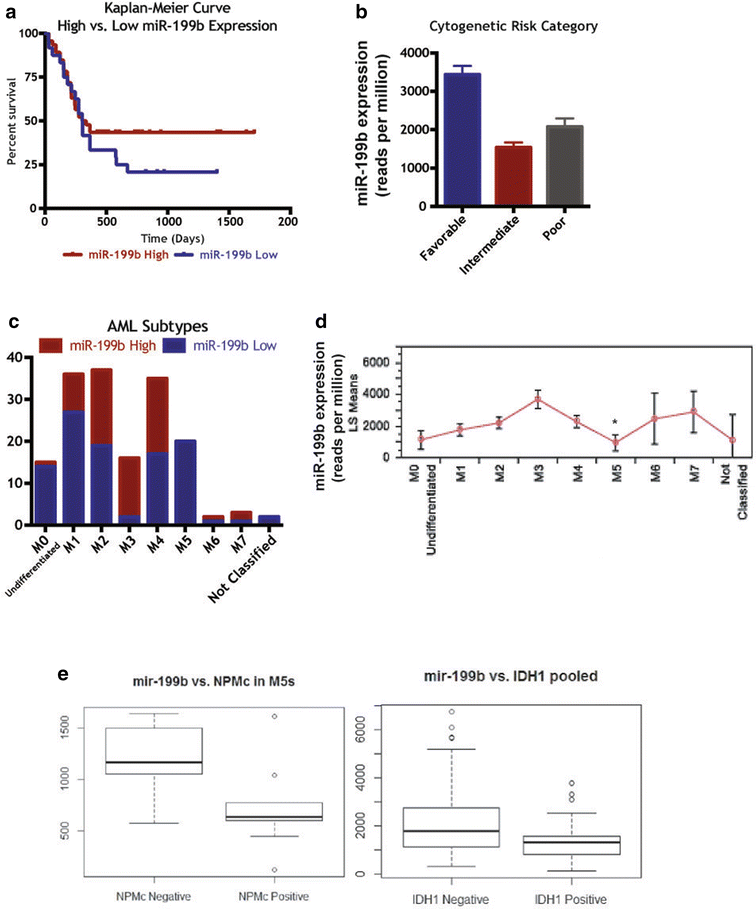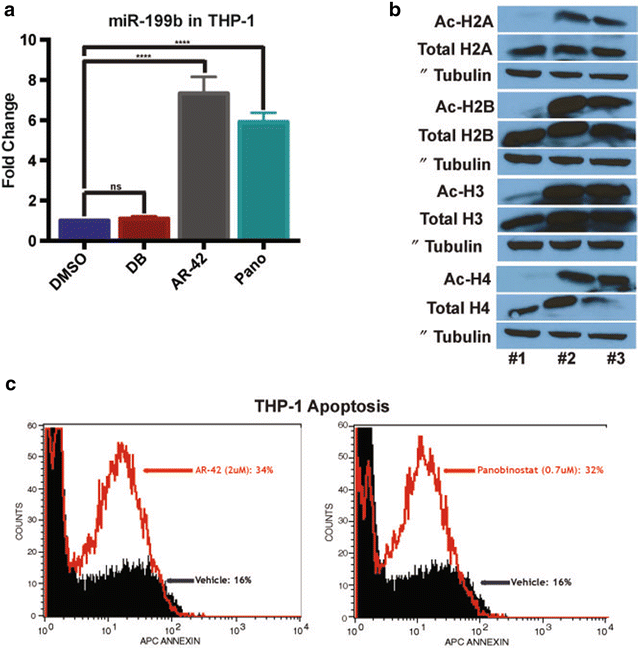miR-199b, a novel tumor suppressor miRNA in acute myeloid leukemia with prognostic implications
- PMID: 26848406
- PMCID: PMC4740997
- DOI: 10.1186/s40164-016-0033-6
miR-199b, a novel tumor suppressor miRNA in acute myeloid leukemia with prognostic implications
Abstract
Background: Dysregulation of miRNAs that can act as tumor suppressors or oncogenes can result in tumorigenesis. Previously we demonstrated that miR-199b was significantly downregulated in acute myeloid leukemia (AML) and targets podocalyxin and discoidin domain receptor 1. Herein we investigated the functional role of miR-199b in AML and its prognostic implications.
Methods: Major approaches include transduction of hematopoietic stem cells and bone marrow transplantation, analyses of blood lineages, histone deacetylases (HDAC) inhibitors, and molecular and clinical data analyses of AML patients using The Cancer Genome Atlas (TCGA).
Results: We first examined the relative miR-199b expression in steady state hematopoiesis and showed CD33(+) myeloid progenitors had the highest miR-199b expression. Further, silencing of miR-199b in CD34(+) cells resulted in significant increases in CFU-GM colonies. Via TCGA we analyzed the molecular and clinical characteristics of 166 AML cases to investigate a prognostic role for miR-199b. The Kaplan-Meier curves for high and low expression values of miR-199b and the observed distribution of miRNA expression revealed the highly expressed group had significantly better survival outcomes (p < 0.016, log rank test). Additionally, there was significant difference between miR-199b expression across the AML subtypes with particularly low expression found in the FAB-M5 subtype. Furthermore, FAB-M5 subtype showed a poor prognosis with a 1-year survival rate of only 25 %, compared with 51 % survival in the overall sample (p < 0.024). Furthermore, significant inverse correlation of HoxA7 and HoxB6 expression with miR-199b was observed in FAB-M5 AML patients. Molecular mutations were analyzed among miR-199b high and low AML cases. Significant correlations in terms of association and survival outcomes were observed for NPMc and IDH1 mutations. Treatment of THP-1 cells (represents M5-subtype) with HDAC inhibitors AR-42, Panobinostat, or Decitabine showed miR-199b expression was significantly elevated upon AR-42 and Panobinostat treatment. To further understand the hematopathological consequences of decreased miR-199b, we employed a bone-marrow transduce/transplant (BMT) mouse model. Interestingly, in vivo miR-199b silencing per-se in HSCs did not result in profound perturbations.
Conclusions: Loss of miR-199b can lead to myeloproliferation while HDAC inhibitors restore miR-199b expression and promote apoptosis. Low miR-199b in AML patients correlates with worse overall survival and has prognostic significance for FAB-M5 subtype.
Keywords: Acute myeloid leukemia; Bone marrow transplant; FAB-M5; HSC; NPM1; miRNA-199b.
Figures





References
-
- Wang C, Song B, Song W, Liu J, Sun A, et al. Underexpressed microRNA-199b-5p targets hypoxia-inducible factor-1alpha in hepatocellular carcinoma and predicts prognosis of hepatocellular carcinoma patients. J Gastroenterol Hepatol. 2011;26(11):1630–1637. doi: 10.1111/j.1440-1746.2011.06758.x. - DOI - PubMed
Grants and funding
LinkOut - more resources
Full Text Sources
Other Literature Sources
Research Materials
Miscellaneous

